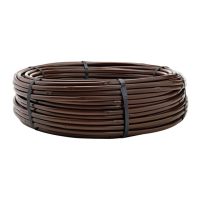N E T A F I M T E C H L I N E
®
C V D E S I G N G U I D E
N E T A F I M T E C H L I N E
®
C V D E S I G N G U I D E
TECHLINE CV
IN TURF
TECHLINE CV IN TURFGRASS:
Background: Netafim products have been used successfully in turfgrass since the 1980's. It is a
popular choice for a variety of residential and commercial general-use and specialized-use turf areas,
and has been used very successfully in sports turf, as well as composition and grass tennis courts.
WHERE AND WHY TO USE TECHLINE CV IN TURF:
• Long, odd-shaped or narrow areas:
– Allows greater landscape design freedom to use curvilinear layouts that cannot be utilized when
overhead irrigation is used
– Eliminates wet roads and sidewalks
– Helps save water
– Reduces slipping and tripping hazards
– Reduces wet surface hazards to vehicle traffic
– The ability to irrigate areas with less water in long narrow areas where either getting the water is
hard, or zoning the area is difficult
– Overspray is eliminated
• Areas close to buildings and at-grade windows:
– Stops windows from getting wet
– Allows the use of turfgrass close to a building without damage to facades
– Reduces deterioration and discoloration of building facades
• Athletic fields:
– No exposed sprinklers reduces impact injuries
– On tight-soil fields:
• Can be irrigated and softened prior to play without wetting the surface
• Helps reduce impact injuries from hard soil surfaces
– Because water window issues are eliminated, time of play increases
• Auto dealerships and other parking areas:
– No overspray reduces the cost of auto detailing
– Reduces slipping and tripping hazards
– Reduces wet surface hazards to vehicle traffic
• High wind, or constant wind areas:
– Overspray and wasted water is eliminated
– Water gets where it is supposed to be regardless of wind
• High liability areas:
– Tripping and other liability issues are significantly reduced
– Maintenance costs to repair broken sprinkler heads are greatly reduced
• Vandal-prone areas:
– “Out of sight, out of mind”
– Maintenance costs and potential liability of unrepaired problems is greatly reduced

